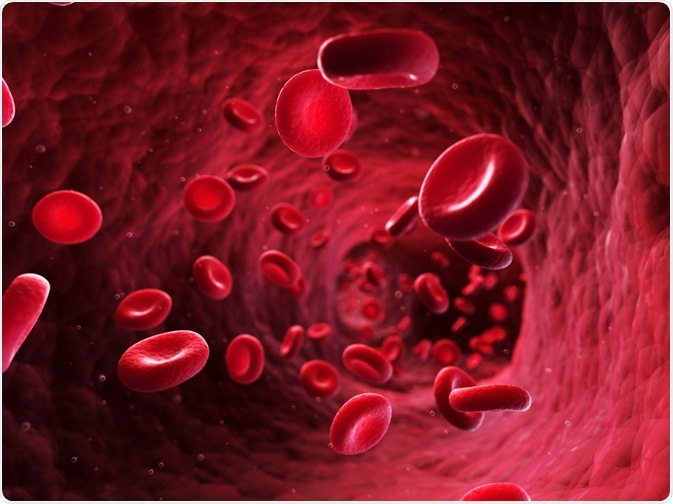Anoxia is a state of total oxygen deprivation within tissues or organs. It is an extreme form of hypoxia – a condition characterized by insufficient availability of oxygen. The damage caused by partial or complete lack of oxygen supply is known as hypoxic/anoxic injury.
 Sebastian Kaulitzki | Shutterstock
Sebastian Kaulitzki | Shutterstock
Anoxia is primarily caused by a lack of blood supply to the tissue, or low oxygen content in the blood. Three physiological processes are vital in maintaining an adequate oxygen level in the blood: perfusion – blood flow to the lung; ventilation – airflow to the lung; and diffusion – the exchange of gases (oxygen/carbon dioxide) between blood and air at the lung. Dysregulation of any one of these processes can lead to severe hypoxia/anoxia injuries.
What are the types of anoxia?
There are four types of anoxia:
Anoxic anoxia
Anoxic anoxia is caused by a lack of oxygen in the air (reduced atmospheric oxygen tension), such as at high altitudes. As a result, less oxygen reaches the blood, resulting in a lack of oxygen supply to the tissues.
Anemic anoxia
Anemic anoxia is occurs when red blood cells lack the ability to carry sufficient oxygen, either due to a reduction in hemoglobin or due an alteration in the capacity of the hemoglobin to carry oxygen. It may also be the result of a deficiency in red blood cells. Health conditions frequently associated with anemic anoxia include lung disorders, chronic anemia, carbon monoxide poisoning, and acute hemorrhage.
Stagnant anoxia (also called hypoxic-ischemic injury)
Stagnant anoxia occurs when blood, although well-oxygenated, is not distributed to the tissues. Stagnant anoxia is caused by conditions such as stroke, heart attack, and cardiac arrhythmias.
Toxic anoxia
Toxid anoxia occurs when toxic substances such as carbon monoxide, cyanide, narcotics, or alcohol are present in the body, restricting the delivery of oxygen to the tissue.
What are the symptoms of anoxia?
Although anoxia can affect any tissue/organ of the body, the brain is most vulnerable. Since the brain requires a large amount of oxygen (20% of the oxygen consumed by the body is taken up by the brain alone) to function normally, the effects of anoxia are most prominent in this organ. Oxygen deprivation for 4 minutes may result in brain cell death, and permanent brain damage is likely if the oxygen supply is not restored within 5 minutes.
The signs and symptoms of anoxic brain injury depend on the duration of anoxia and the intensity of damage. The most vulnerable areas of the brain are the cerebral cortex, the hippocampus, the basal ganglia, and the cerebellum.
Short-term effects of anoxia
In the case of mild anoxia (shorter duration), the initial symptoms include lack of attention, concentration, coordination and short-term memory loss. These symptoms may be associated with headache, dizziness, hyperventilation, and sweating.
If anoxia persists for a longer duration, the extent of brain damage may be severe. This may subsequently result in confusion, agitation, peripheral cyanosis (bluish discoloration of the skin around the lips, mouth, and fingertips), myoclonus (jerky contraction of muscles), and seizures. Extreme anoxia can lead to loss of consciousness and coma.
Rarely, severe anoxia can damage the hypothalamus and pituitary gland. This can lead to hormonal imbalance and the development of neurogenic diabetes insipidus – a condition caused by the reduced secretion of the hormone vasopressin, and characterized by increased thirst and excessive urination.
Long-term effects of anoxia
Long-term effects of anoxia depend mainly on the degree of irreversible brain damage and the area of damage.
If anoxia has been prolonged sufficiently to result in significant brain injury, it may result in coma. After recovery, symptoms such as memory lapse, movement disorders, weakness of the arms and legs, and neuropsychological issues like depression and stress intolerance, may manifest.
Other long-term effects include:
- Anoxic injury to the cerebral cortex, cerebellum, and basal ganglia can cause impaired locomotion, balance, and coordination.
- Damage to the occipital lobe of the cerebral cortex could cause visual impairment (cortical blindness).
- Damage to the hippocampus can lead to memory-related problems.
- Damage to the frontal lobe in the dominant hemisphere can cause speech and language-related problems. Frontal lobe injury can also result in impaired thinking, reasoning, and decision-making. In addition, it may induce changes in mood, personality, and social behavior.
How is anoxic brain damage diagnosed?
The outcome of anoxic brain injury may often be fatal if not diagnosed early. Several factors interact to predict the outcome, such as age, duration of anoxia, duration of coma, and pupil reaction.
In most cases, the diagnosis is based on the following tests:
- Electroencephalogram (EEG) – it measures the electrical activity of the brain. An abnormal EEG indicates a poor chance of survival, or survival with severe disability.
- Brain imaging – an MRI or a CT scan is often used to investigate brain swelling, degree, and area of damage. These are important in predicting the neurological outcomes (the level of permanent disability) in patients.
- Somatosensory evoked potentials (SSEPs) – these reveal the electrical activity of the brain in response to stimulation of nerves in the wrist. Absent SSEP signal is associated with a poor prognosis.
Further Reading